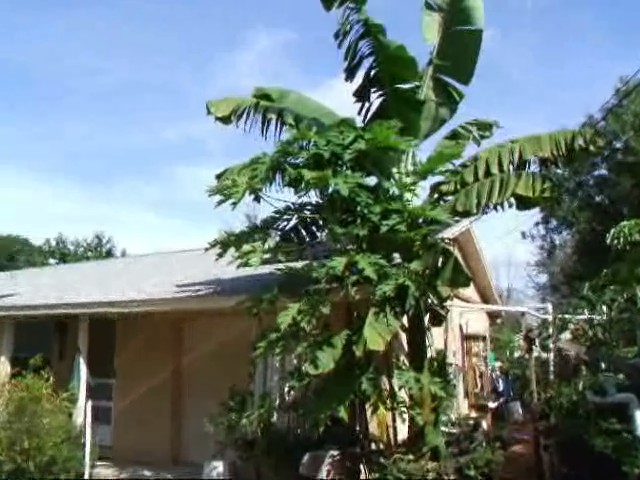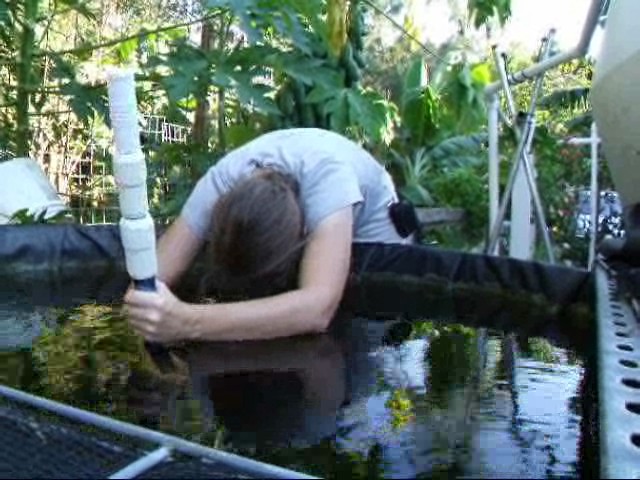Aquaponics Sump tank, Why?
Either to deal with water level fluctuations or gravity drains or both.
So once you decide you need a sump tank, you then need to figure out how big it needs to be.
Start out by figuring out the total volume of all the flood and drain Media grow beds you need to handle flooding and draining at the same time. Then you figure that your media will displace about half the volume of those beds (it will actually displace more but we want to have some extra sump volume so go with 50% since it makes the math easier anyway. Us some volume calculator on the web if you need to figure from cubic inches or feed into gallons or liters and then figure out the total volume needed.
So if you have 1000 gallons of grow beds total and figure that leaves needing about 500 gallons of sump tank volume to handle flooding the beds all at once, then you should look for a sump tank that will hold at least 500 gallon but I often recommend going about 10% extra just so you have some added depth for your pump to operate (most can’t pump a tank down to dry ya know) and it’s kinda handy to also install a float controlled top up valve just below the normal low water level but above the pump overheating or sucking air level.
This calculation works well in basic systems but keep in mind that a nearly empty sump tank sunk into the ground in a greenhouse while there is a downpour all around might have a tendency to float out of the hole, this can do quite a bit of damage to the plumbing and the hole as well as create a HSM (heart stopping moment) when the owner of the aquaponics system discovers the damage. Also very shallow but large footprint sumps might be easier to fit under grow beds without digging them into a hole but they will also not provide much depth for the pump to work in and there for may need to be even larger to accommodate the operational depth of most pumps.





thsi is very helpful . just starting out in Aquaponics ..I like it alot …
I am building 12 tanks in series, each 6.25 m long, 2m wide and 1.2 m deep, connected with two 3 inch poly pipe in walls tying tanks outer wall to building.
so building wall up to 1.2m is part of fish tank wall. These total 50,000 gallons.
The idea started to cool air down before entering the building’s louvres.
Then aquaponics was suggested, and 60 sq mtrs of beds are CHB 12 inch deep, built on rain water tanks, so height of 1.1 fish tank drains into 1m high veg beds, into sump of 4 cu mtrs, then pumped 17 mtrs back into start of fish tanks (at 1.5 mtr high fountain), which surround building on 3 sides.
I have a davey whisper 1000M 0.86 KW above ground swimming pool pump that has run 24/7 and dry sometimes when priming, and which i will use as a spare.
I will buy a similar size 3 speed pump for 50,000 gallons on slow speed(13,000LPM?) as it runs at 10% of the cost and 85% efficiency at slow speed, and add growing beds, to the existing 60 sq mtrs, until the water flows round at normal speed of 13,000lpm?
It is all head knowledge so far, so i will start off small with free tilapia fingerlings from municipality, and with 3 air pumps hoping to keep them alive during brownouts.
I have to feed 30 bible students to begin with, and also up to 200 Compassion families the church looks after, when i have learnt more and install more grow beds.
It is a labour of love in my retirement.
I want to keep it as simple as possible, but am asking what size water pump should I buy? and one with similar plumbing to my davey so i can exchange them quickly if the pump fails.
Also what size air pumps should I buy for the 12 fish tanks and 3 similar size rain water tanks?
kind regards, richard.
Sorry i should add the fish will be tilapia to begin with and the project is in the Philippines.
What consideration would you include as far as grow bed to fish tank ratio if you wanted to use the sump tank as a floating raft tank for lettuce or whatnot? I know with a sump tank the ratio can be increased from 1:1 to 2:1 or even 3:1. If you’re going to use the sump tank as a floating raft also, would you include the number of gallons in the grow bed side of the ratio? I know the ratios are for rough estimates of nutrient requirements of the plants and nutrient extraction so the fish have cleaner water and just testing would let me know exactly, but still, for planning purposes just wondering if someone has experience trying this. Thanks
To be clear “would you include the number of gallons OF THE SUMP/FLOATING TANK in the grow bed side of the ratio”?
Those ratios are for media bed aquaponics raft aquaponics is quite different when figuring filtration and amount of fish in relation to plant space
So I just saw on Murray Hallam’s website that solids settle in the sump tank. I know that’s a no-no for floating raft. The roots attract that stuff and suffocate. I’m wondering if an addition of substrate under the rafts and some sort of detritivore like freshwater prawns or crawfish would take care of that.
No, you actually need to either do ultra low density fish stocking or have some form of filtration between the fish tank and the raft bed
You could incorporate a swirl filter from your fish tank to your sump tank to eliminate the solid waste before it enters the sump. This would allow you to use your sump tank as a clean DWC / Float tank. I have this setup and it works out well. I use my sump tank to start my young plants before planting in my media beds and I have had no problem with “slime” on the roots. Of course my system is a CHOP or constant height one pump system. My media grow beds empty into my fish tank and I have a straw type overflow siphon from my fish tank to swirl filter then sump tank.
This can work, provided you are able to afford a swirl filter that is large enough to allow for adequate settling of the solids at the flow rate you are passing though your fish tank. I’ve noticed that people often make filters that are too small for their flow rate and hence are not as effective.
Of course if you are only leaving seedlings in the sump/float bed for three weeks you would probably even manage with little to no settling out as long as your pump is adequately sucking up the solids to keep a large build up from happening, in which case you would just need to do a regular sump clean up.